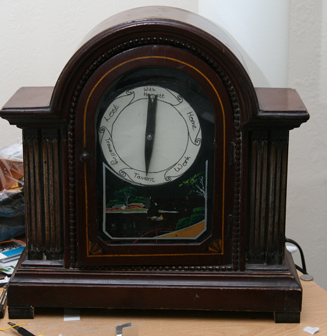
The location clock found in the Harry Potter books makes for a really fun hack. Of course there’s no magic involved, just a set of hardware to monitor your phone’s GPS and a clock face to display it.
[Alastair Barber] finished building the clock at the end of last year as a Christmas gift. The display seen above uses an old mantelpiece clock to give it a finished look. He replace the clock face with a print out of the various locations known to the system and added a servo motor to drive the single hand. His hardware choices were based on what he already had on hand and what could be acquired cheaply. The an all-in-one package combines a Raspberry Pi board with a USB broadband modem to ensure that it has a persistent network connection (we’ve seen this done using WiFi in the past). The RPi checks a cellphone’s GPS data, compares it to a list of common places, then pushes commands to the Arduino which controls the clock hand’s servo motor. It’s a roundabout way of doing things but we imagine everything will get reused when the novelty of the gift wears off.














Go Durham!
See there’s more than one of us that frequents hackaday
I found a bigger pic http://www.alastairbarber.com/data/uploads/finished_clock.jpg
Does this work the way you think it does?
It seems that the position has to be updated manually rather than by tracking GPS.
less creepy at least
Hi,
Right now it works just manually, unfortunately I never really got round to the GPS bit. As I’m not in possession of an Apple Developer account and use an iPhone the GPS app bit wasn’t really in the pipeline, although I was thinking there might be some kind of JavaScript way of getting the location? I think I mention somewhere that I’d like to try and make a better way of updating it ’cause having to go to a web page on the phone every time I go somewhere is a pain, so that would definitely have a GPS & mobile data pairing somewhere, probably just in my bag or something – so not completely tracked ;) – Currently messing around the the Arduino USB shield to see if I can get that working somehow…
If you are just using the Arduino to drive the servo, you don’t need it. There is a package for the Pi called ‘servoblaster’ which will allow you to drive a servo from one of the Pi’s GPIO pins.
This one is from 2009: http://www.themagicclock.com